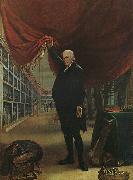Wholesale Oil Painting No Minimum |
|||||||||||
|
|
|||||||||||

|
|||||||||||
|
|
|
||||||||
Charles Wilson Peale1741-1827 Charles Wilson Peale Galleries Finding that he had a talent for painting, especially portraitures, Peale studied for a time under John Hesselius and John Singleton Copley. Friends eventually raised enough money for him to travel to England to take instruction from Benjamin West. Peale studied with West for two years beginning in 1767, afterward returning to America and settling in Annapolis, Maryland. There, he taught painting to his younger brother, James Peale, who in time also became a noted artist. Peale's enthusiasm for the nascent national government brought him to the capital, Philadelphia, in 1776, where he painted portraits of American notables and visitors from overseas. His estate, which is on the campus of La Salle University in Philadelphia, can still be visited. He also raised troops for the War of Independence and eventually gained the rank of captain in the Pennsylvania militia by 1777, having participated in several battles. While in the field, he continued to paint, doing miniature portraits of various officers in the Continental Army. He produced enlarged versions of these in later years. He served in the Pennsylvania state assembly in 1779-1780, after which he returned to painting full-time. Peale painted in the trompe l'oeil style,[1] and was quite prolific as an artist. While he did portraits of scores of historic figures (such as John Hancock, Thomas Jefferson and Alexander Hamilton), he is probably best known for his portraits of George Washington. The first time Washington ever sat for a portrait was with Peale in 1772, and there would be six other sittings; using these seven as models, Peale produced altogether close to 60 portraits of Washington. In January 2005, a full length portrait of "Washington at Princeton" from 1779 sold for $21.3 million dollars - setting a record for the highest price paid for an American portrait. Peale had a great interest in natural history, and organized the first U.S. scientific expedition in 1801. These two major interests combined in his founding of what became the Philadelphia Museum, and was later renamed the Peale Museum. This museum is considered the first. It housed a diverse collection of botanical, biological, and archaeological specimens. Most notably, the museum contained a large variety of birds which Peale himself acquired, and it was the first to display North American mammoth bones. The display of the mammoth bones entered Peale into a long standing debate between Thomas Jefferson and Comte de Buffon. Buffon argued that Europe was superior to the Americas biologically, which was illustrated through the size of animals found there. Jefferson referenced the existence of these mammoths (which he believed still roamed northern regions of the continent) as evidence for a greater biodiversity in America. Peale's display of these bones drew attention from Europe, as did his method of re-assembling large skeletal specimens in three dimensions. The museum was among the first to adopt Linnaean taxonomy. This system drew a stark contrast between Peale's museum and his competitors who presented their artifacts as mysterious oddities of the natural world. The museum underwent several moves during its existence. At various times it was located in several prominent buildings including Independence Hall and the original home of the American Philosophical Association. The museum would eventually fail in large part because Peale was unsuccessful at obtaining government funding. After his death, the museum was sold to, and split up by, showmen P. T. Barnum and Moses Kimball. |
||||||||
|
|
||||||||
The Artist in his Museum
The Artist in his Museum Painting ID:: 4263 |
1822
Pennsylvania Academy of Fine Arts 1822 Pennsylvania Academy of Fine Arts |
|||||||
|
|
||||||||
|
Charles Willson Peale 1741-1827 Painter and museum founder. After serving as a saddler's apprentice in Annapolis, MD, from 1754 to 1761, he worked at various trades, including painting signs and portraits. In 1766 some prominent Marylanders underwrote his studies in London with Benjamin West, from whom he absorbed the fundamentals of the British portrait tradition. Peale probably attended the informal life classes offered at St Martin's Lane Academy, precursor to the Royal Academy Schools, and drew from casts in the Duke of Richmond's collection in Whitehall. He visited the studios of such important British portrait painters as Joshua Reynolds, Francis Cotes and Allan Ramsay and studied the techniques of miniature painting, sculpture and engraving. In London he executed his first major commission The Artist in his Museum mk52 1822 Oil on canvas 263.2x202.6cm Pennsylvania Academy of the Fine Arts,Philadelphia |
||||||||
|
|
||||||||
|
Prev Next
|
||||||||
|
|
||||||||
|
Related Paintings to Charles Willson Peale :. |
||||||||
|
|
||||||||
|
CONTACT US |

